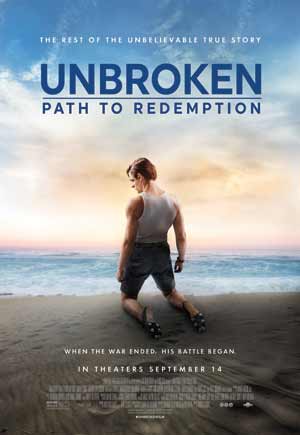
DAV life member Louis Zamperini’s story is one of survival, but new film shows the battle he faced when he returned home
Four years after the premiere of the movie “Unbroken”—based on Laura Hillenbrand’s bestselling book of the same name—a sequel is set to debut. “Unbroken: Path to Redemption,” opening in theaters Sept. 14, picks up where the 2014 film left off and dives deeper into the internal struggles faced by many veterans returning from war.
“Unbroken: Path to Redemption” continues the true story of Olympian, World War II prisoner of war and DAV life member Louis Zamperini. After surviving a plane crash, weeks of floating on a makeshift raft in the Pacific and then years of torture as a prisoner of war in Japan, Zamperini finally returned to his home in California, seemingly unbroken, but his internal battle and spiritual journey had just begun. Haunted by nightmares of his torment, Zamperini saw himself as anything but a hero.
“I think of war as not so much an assault on the body; it is perhaps more so an assault on the mind,” said Hillenbrand, who spent four years researching the book, working closely with Zamperini. “It damages people emotionally. It wounds people emotionally. We like to think the war is over and everybody goes back to being fine, but that’s not what happens. People carry those wars out of the theaters and into their homes and their lives. They need help often, and struggle their way out of it. Louie is a perfect example of that.”
Samuel C. Hunt, who portrays Zamperini, said Zamperini’s very open account of his struggles with alcoholism and hopelessness after his return home—and how his mental state affected his family—is an example of human resiliency.
“His experiences were extraordinary,” said Hunt. “As the actor, it was important for me to have some form of understanding of what it meant to me in my life. If we respect everyone’s trauma—and try to be empathetic—then we can understand it better and help them heal.”
Veterans with invisible wounds—whether post-traumatic stress, traumatic brain injuries, substance abuse disorders or other mental health challenges—can almost all relate to the internal strife Zamperini experienced, documented so thoroughly in Hillenbrand’s book. DAV has long been an advocate for quality care, resources and research into helping veterans and their families who are suffering from service-connected trauma and mental health issues. DAV aided Hillenbrand during her initial research into Zamperini’s story, help she said she is grateful for.
Prior to the film’s release date, veterans in Washington, D.C., were invited to screen the film. DAV Washington Headquarters Executive Director Garry Augustine said the issues depicted in the movie are relevant to veterans today, just as much as they have been to the generations of veterans before.
“Louie’s story is a reminder to all of us that we can’t heal ourselves alone,” said Augustine. “We know more today about mental health and the effects of war than we did when he came home after World War II, but today’s veterans are facing the same life-altering experiences that can make or break them. It is up to us—as fellow veterans and as human beings—to provide the support and resources our heroes deserve.”

